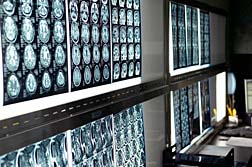 According to the researchers, "… case control studies suggest a strong association between the use of gadolinium based magnetic resonance imaging contrast agents and the subsequent development of nephrogenic systemic fibrosis in patients with renal disease." Furthermore, researchers found that the risk of NSF depends on, " the degree of renal dysfunction, dose of contrast agent, gadolinium contrast agent stability and severity of concomitant illness." The risk of NSF after exposure to a gadolinium-based contrast agent in patients with renal failure can vary from a negligible amount up to 5 percent in high-risk cases.
According to the researchers, "… case control studies suggest a strong association between the use of gadolinium based magnetic resonance imaging contrast agents and the subsequent development of nephrogenic systemic fibrosis in patients with renal disease." Furthermore, researchers found that the risk of NSF depends on, " the degree of renal dysfunction, dose of contrast agent, gadolinium contrast agent stability and severity of concomitant illness." The risk of NSF after exposure to a gadolinium-based contrast agent in patients with renal failure can vary from a negligible amount up to 5 percent in high-risk cases.Researchers recommend that patients with renal dysfunction be given gadolinium-based contrast agents "judiciously," and the use should be determined on a case by case basis with the risks and benefits being carefully considered. The study was conducted by reviewing the PubMed database and other databases that are publicly available.
The study supports previous research that also found associations between the use of gadolinium contrast dyes and NSF. One study, published in 2006 in the journal Nephrology, Dialysis and Transplanatation, found that some patients who underwent an MRA with gadolinium dyes developed symptoms of NSF within weeks of the procedure. Some of the patients involved in the study later died from complications related to NSF.
Nephrogenic Systemic Fibrosis is a potentially fatal condition marked by a hardening of the skin, severe stiffness in the joints and muscle weakness. Other symptoms include high blood pressure and a burning or itching sensation. Tissue around internal organs can harden, resulting in organ failure and death. The risk of NSF is serious enough that the Food and Drug Administration (FDA) requested a black box warning for gadolinium contrast dyes in 2007. Patients with kidney disease are warned to avoid gadolinium contrast dyes where possible.
READ MORE GADOLINUM CONTRAST AGENTS LEGAL NEWS
Patients who developed NSF after exposure to gadolinium have filed lawsuits alleging they were not properly warned about the risks associated with the use of some contrast dyes. Approximately 400 people are reported to have developed NSF following exposure to MRI contrast dyes. Those dyes include Magnevist, Ominiscan, OptiMARK, MultiHance and Prohance. People who were given a gadolinium-based contrast dye for an MRI or MRA procedure and believe they are suffering from NSF should seek medical attention immediately.
